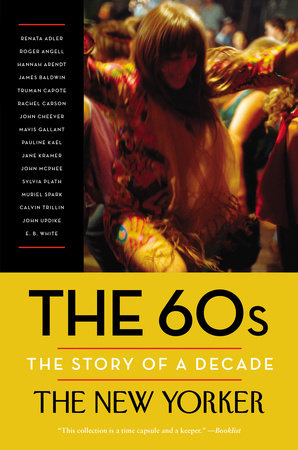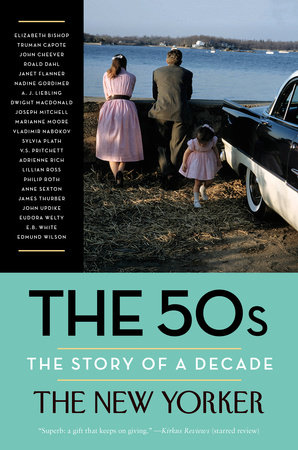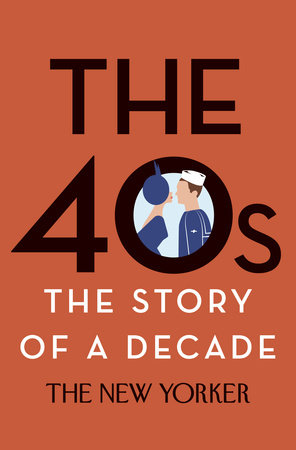Excerpt
The 60s: The Story of a Decade
Part One Reckonings
A Note by George Packer
These days, the quarter century between the Second World War and the 1970s seems like at least an American silver age. The middle class was big and prosperous. Leaders in government, business, and labor worked out compromises that kept the deal table level and the payout fair. National institutions worked pretty well, and under stress they didn’t collapse. Congress responded to civil-rights protests with sweeping, bipartisan legislation; environmental awareness produced the Clean Air and Clean Water Acts. As Richard H. Rovere wrote in “Half Out of Our Tree,” even the protests over the war in Vietnam showed that American democracy still had a pulse—a strong one by today’s standards.
Read the journalism of the 1960s and you might not think so. If the country now seems to be painfully breaking down, in the sixties it was quite dramatically exploding. The sense of continuous crisis forced a change in the journalism that appeared in The New Yorker. The magazine lost its habitual cool, its restraint. It began to publish big, ambitious reports and essays that attempted to meet the apocalyptic occasion. These pieces were intended to make noise, even to shock the national mind, and they dominated conversation for weeks or months. In the sixties, The New Yorker acquired a social consciousness. It went into opposition, challenging the complacent postwar consensus that had prevailed across American culture, including in its pages. The result was some of the most famous and influential journalism ever to appear in the magazine.
This work occupied so much territory—paid for by the voluminous and high-end advertising that used to fill The New Yorker’s pages—that some of the pieces took up an entire issue, or else spread themselves out over two, three, or even five in succession. Ambitious work had often appeared in the magazine, but the pieces from the sixties were something more than stories enjoying the luxury of a lot of space to be well and fully told. This was journalism as event. Sometimes the events arrived so fast and thick that readers could barely catch their breath. Rachel Carson’s warning of the effects of chemical spraying on birds, trees, and other living things—published in the late spring of 1962—is now credited with starting the environmental movement. Five months later, James Baldwin’s autobiographical essay on the black church, the Nation of Islam, and the racial crisis detonated, making him a prophet of the civil-rights era, Jeremiah to Martin Luther King, Jr.’s Moses, and that rare thing in American letters—the writer as national oracle. No less a personage than Bobby Kennedy felt prompted to answer “Letter from a Region of My Mind,” privately, leading to an angry exchange between the two in Kennedy’s midtown Manhattan apartment.
Just a few months later, in early 1963, The New Yorker published a report on the trial in Jerusalem of the Nazi criminal Adolf Eichmann, by the German-Jewish writer Hannah Arendt: a piece of political philosophy that simultaneously raised the repressed horror of the Holocaust and interrogated its perpetrators and victims alike—the former for their supposed banality, the latter for failing to put up a fight. Nor did Arendt try to conceal her contempt for the new state of Israel. From an Olympian perch, she flung down complex, razor-edged sentences that couldn’t fail to hurt. The writers known as the New York intellectuals were thrown into an uproar, published replies, replied to the replies, broke into pro- and anti-Arendt camps, and debated the piece at a legendary town-hall meeting that Arendt herself disdained to attend.
In the middle of the decade came Truman Capote’s In Cold Blood, about the killing of a family of four in Kansas. The murders had taken place in 1959, and the story of lonely, doomed small-town Americans feels as if it’s in black and white, not Technicolor. But Capote’s literary method helped define the experimental journalism of the sixties. In Cold Blood was shocking above all for its style, which dared to enter the dream life of a killer, to flirt dangerously along the borderline between fact and fiction. Jonathan Schell’s “The Village of Ben Suc” was more conventional in its reportorial approach—dispassionate and meticulous—but devastating in its description of the American war machine turned loose on one corner of South Vietnam. The piece conveys the madness of overpowering technology and geopolitical dogma wreaking havoc, with no ability to see or understand the targets of destruction.
The sixties introduced the idea, reluctantly acknowledged in Rovere’s essay “Half Out of Our Tree,” that something had gone wrong with America—that we could no longer assume ourselves to be good. The New Yorker registered this change in many departments, but nowhere more memorably than in its journalism. These heavyweight pieces did not just record the decade’s drama—they became part of it.
from Silent Spring—1
Rachel Carson
June 16, 1962
There was once a town in the heart of America where all life seemed to be in harmony with its surroundings. The town lay in the midst of a checkerboard of prosperous farms, with fields of grain and hillsides of orchards, where white clouds of bloom drifted above the green land. In autumn, oak and maple and birch set up a blaze of color that flamed and flickered across a backdrop of pines. Then foxes barked in the hills and deer crossed the fields, half hidden in the mists of the mornings. Along the roads, laurel, viburnum, and alder, great ferns and wild flowers delighted the traveller’s eye through much of the year. Even in winter, the roadsides were places of beauty, where countless birds came to feed on the berries and on the seed heads of the dried weeds rising above the snow. The countryside was, in fact, famous for the abundance and variety of its bird life, and when the flood of migrants was pouring through in spring and fall, people came from great distances to observe them. Other people came to fish streams, which flowed clear and cold out of the hills and contained shady pools where trout lay. So it had been from the days, many years ago, when the first settlers raised their houses, sank their wells, and built their barns.
Then, one spring, a strange blight crept over the area, and everything began to change. Some evil spell had settled on the community; mysterious maladies swept the flocks of chickens, and the cattle and sheep sickened and died. Everywhere was the shadow of death. The farmers told of much illness among their families. In the town, the doctors were becoming more and more puzzled by new kinds of sickness that had appeared among their patients. There had been several sudden and unexplained deaths, not only among the adults but also among the children, who would be stricken while they were at play, and would die within a few hours. And there was a strange stillness. The birds, for example—where had they gone? Many people, baffled and disturbed, spoke of them. The feeding stations in the back yards were deserted. The few birds to be seen anywhere were moribund; they trembled violently and could not fly. It was a spring without voices. In the mornings, which had once throbbed with the dawn chorus of robins, catbirds, doves, jays, and wrens, and scores of other bird voices, there was now no sound; only silence lay over the fields and woods and marshes. On the farms, the hens brooded but no chicks hatched. The farmers complained that they were unable to raise any pigs; the litters were small, and the young survived only a few days. The apple trees were coming into bloom, but no bees droned among the blossoms, so there was no pollination and there would be no fruit. The roadsides were lined with brown and withered vegetation, and were silent, too, deserted by all living things. Even the streams were lifeless. Anglers no longer visited them, for all the fish had died. In the gutters under the eaves, and between the shingles of the roofs, a few patches of white granular powder could be seen; some weeks earlier this powder had been dropped, like snow, upon the roofs and the lawns, the fields and the streams. No witchcraft, no enemy action had snuffed out life in this stricken world. The people had done it themselves.
This town does not actually exist; I know of no community that has experienced all the misfortunes I describe. Yet every one of them has actually happened somewhere in the world, and many communities have already suffered a substantial number of them. A grim spectre has crept upon us almost unnoticed, and soon my imaginary town may have thousands of real counterparts. What is silencing the voices of spring in countless towns in America? I shall make an attempt to explain.
•••
The history of life on earth is a history of the interaction of living things and their surroundings. To an overwhelming extent, the physical form and the habits of the earth’s vegetation and its animal life have been molded and directed by the environment. Over the whole span of earthly time, the opposite effect, in which life modifies its surroundings, has been relatively slight. It is only within the moment of time represented by the twentieth century that one species—man—has acquired significant power to alter the nature of his world, and it is only within the past twenty-five years that this power has achieved such magnitude that it endangers the whole earth and its life. The most alarming of all man’s assaults upon the environment is the contamination of the air, earth, rivers, and seas with dangerous, and even lethal, materials. This pollution has rapidly become almost universal, and it is for the most part irrecoverable; the chain of evil it initiates, not only in the world that must support life but in living tissues, is for the most part irreversible. It is widely known that radiation has done much to change the very nature of the world, the very nature of its life; strontium 90, released into the air through nuclear explosions, comes to earth in rain or drifts down as fallout, lodges in soil, enters into the grass or corn or wheat grown there, and, in time, takes up its abode in the bones of a human being, there to remain until his death. It is less well known that many man-made chemicals act in much the same way as radiation; they lie long in the soil, and enter into living organisms, passing from one to another. Or they may travel mysteriously by underground streams, emerging to combine, through the alchemy of air and sunlight, into new forms, which kill vegetation, sicken cattle, and work unknown harm on those who drink from once pure wells. As Albert Schweitzer has said, “Man can hardly even recognize the devils of his own creation.” It took hundreds of millions of years to produce the life that now inhabits the earth—aeons of time, in which that developing and evolving and diversifying life reached a state of adjustment to its surroundings. To be sure, the environment, rigorously shaping and directing the life it supported, contained hostile elements. Certain rocks gave out dangerous radiation; even within the light of the sun, from which all life draws its energy, there were short-wave radiations with power to injure. But given time—time not in years but in millennia—life adjusted, and a balance was reached. Time was the essential ingredient. Now, in the modern world, there is no time. The speed with which new hazards are created reflects the impetuous and heedless pace of man, rather than the deliberate pace of nature. Radiation is no longer merely the background radiation of rocks, the bombardment of cosmic rays, the ultraviolet of the sun, which existed before there was any life on earth; radiation is now also the unnatural creation of man’s tampering with the atom. The chemicals to which life is asked to make its adjustment are no longer merely the calcium and silica and copper and the rest of the minerals washed out of the rocks and carried in rivers to the sea; they are also the synthetic creations of man’s inventive mind, brewed in his laboratories and having no counterparts in nature. To adjust to these chemicals would require time on the scale that is nature’s; it would require not merely the years of a man’s life but the life of generations. And even this would be futile, for the new chemicals come in an endless stream; almost five hundred annually find their way into actual use in the United States alone. The figure is staggering and its implications are not easily grasped: five hundred new chemicals to which the bodies of men and all other living things are required somehow to adapt each year—chemicals totally outside the limits of biological experience.
Among the new chemicals are many that are used in man’s war against nature. In the past decade and a half, some six hundred basic chemicals have been created for the purpose of killing insects, weeds, rodents, and other organisms described in the modern vernacular as “pests.” In the form of sprays, dusts, and aerosols, these basic chemicals are offered for sale under several thousand different brand names—a highly bewildering array of poisons, confusing even to the chemist, which have the power to kill every insect, the “good” as well as the “bad,” to still the song of birds and to stop the leaping of fish in the streams, to coat the leaves with poison and to linger on in soil. It may prove to be impossible to lay down such a barrage of dangerous poisons on the surface of the earth without making it unfit for all life. Indeed, the term “biocide” would be more appropriate than “insecticide”—all the more appropriate because the whole process of spraying poisons on the earth seems to have been caught up in an endless spiral. Since the late 1940s, when DDT began to be used widely, a process of escalation has been going on in which ever more toxic chemicals must be found. This has happened because insects, in a triumphant vindication of Darwin’s principle of the survival of the fittest, have consistently evolved super-races immune to the particular insecticide used, and hence a deadlier one has always had to be developed—and then a deadlier one than that. It has happened also that destructive insects often undergo a “flareback,” or resurgence, after spraying, in numbers greater than before. The chemical war is never won, and all life is caught in its cross fire.
Along with the possibility of the extinction of mankind by nuclear war, a central problem of our age is the contamination of man’s total environment with substances of incredible potential for harm—substances that accumulate in the tissues of plants and animals, and even penetrate the germ cells, to shatter or alter the very material of heredity, upon which the shape of the future depends. Some would-be architects of our future look toward a time when we will be able to alter the human germ plasm by design.






